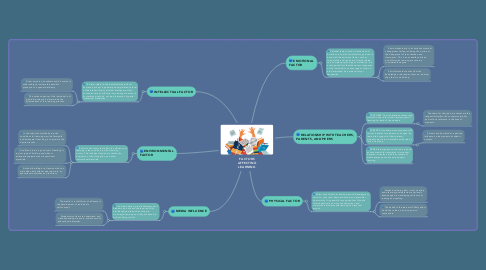
1. ENVIRONMENTAL FACTOR
1.1. Refers to the factor that affect the efficiency of learning is the condition in which learning occurs. This includes classrooms, textbooks, equipment, school supplies, and other instructional materials.
1.1.1. In the school and at the home, the conditions for learning must be favorable and adequate if teaching is to produce the desired results.
1.1.2. It is difficult to do a good job of teaching in a poor type of building and without adequate equipment and instructional materials.
1.1.3. A school building or a classroom has no merit when built without due regard to its educational objectives and functions.
2. INTELLECTUAL FACTOR
2.1. The term refers to the individual mental level. Success in school is generally closely related to level of the intellect. Pupils with low intelligence often encounter serious difficulty in mastering schoolwork. Sometimes pupils do not learn because of special intellectual disabilities.
2.1.1. A low score in one subject and his scores in other subjects indicate the possible presence of a special deficiency.
2.1.2. The native capacity of the individual is of prime importance in determining the effectiveness of the, learning process.
3. MEDIA INFLUENCE
3.1. The media have a great advantage but if students do not have the required skills well developed they do not acquire meaningful learning and they will develop without being critical.
3.1.1. The media is a vital factor of influence in the development of individual's self-concept.
3.1.2. Students must learn to understand and critically develop means to achieve various educational objectives.
4. EMOTIONAL FACTOR
4.1. Personal factors, such as instincts and emotions, and also social factors go hand in hand with the emotional factor, such as cooperation and rivalry, are directly related to a complex psychology of motivation. It is a recognized fact that the various responses of the individual to various types of stimuli are determined by a wide variety of tendencies.
4.1.1. Some students are in a continuous state of unhappiness for fear of being the victims of the disapproval of their teachers and classmates. This is an unhealthy attitude and affects the learning process to a considerable degree.
4.1.2. Social discontent arises from the knowledge or deception that one is below the others in well-being.
5. PHYSICAL FACTOR
5.1. Refers such factors as health, physical development, nutrition, visual and physical defects, and glandular abnormality. It is generally recognized that ill health retards physical and motor development, and malnutrition interferes with learning and physical growth.
5.1.1. Students suffering from visual, auditory, and other physical defects are seriously handicapped in developing skills such as reading and spelling.
5.1.2. The health of the learner will likely affect his ability to learn and his power to concentrate.
6. RELATIONSHIP WITH TEACHERS, PARENTS, AND PEERS
6.1. TEACHERS: The link between teacher and student is key to favor the development of learning for each of the students.
6.1.1. Teachers, for their part, must assume the responsibility that this connection implies and act as a reference in the lives of students.
6.2. PARENTS involvement is associated with various benefits for students of all ages. By feeling the support of their parents, students are more motivated and develop a love of learning.
6.2.1. Parents involvement has a positive influence on the students’ academic success.
